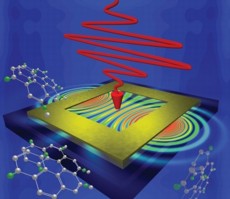Science
NASA Mars Rover Targets Unusual Rock on Its Journey

The drive by NASA's Mars rover Curiosity during the mission's 43rd Martian day, or sol, (Sept. 19, 2012) ended with this rock about 8 feet (2.5 meters) in front of the rover.
- Read more
- 391 reads
Photocatalysis as an energy source: Zn-Ga-O nanocubes improve conversion rate

Chinese researchers have developed a new nanomaterial to improve the chemical conversion rate in photocatalytic energy systems.
- Read more
- 449 reads
Near-Field Enhancements along Ring-Shaped Nanostructures

The near-field enhancement on the surface of ring-shaped gold nanostructure becomes homogeneous through circularly polarized light.
- Read more
- 567 reads
Dawn Sees Hydrated Minerals on Giant Asteroid

Pitted Terrain in Color
These enhanced-color views from NASA's Dawn mission show an unusual "pitted terrain" on the floors of the craters named Marcia (left) and Cornelia (right) on the giant asteroid Vesta.
- Read more
- 393 reads
NASA's Solar Fleet Peers Into Coronal Cavities

Scientists want to understand what causes giant explosions in the sun's atmosphere, the corona, such as this one. The eruptions are called coronal mass ejections or CMEs and they can travel toward Earth to disrupt human technologies in space. To better understand the forces at work, a team of researchers used NASA data to study a precursor of CMEs called coronal cavities.
- Read more
- 389 reads
Iran Urges Asian Nations to Adopt Single Standard for Nanotechnology

- Read more
- 442 reads
Researchers Brew Up Organics on Ice

Researchers are brewing up icy, organic concoctions in the lab to mimic materials at the edge of our solar system and beyond. The laboratory equipment at NASA's Jet Propulsion Laboratory in Pasadena, Calif., is seen at right, and a very young solar system, with its swirling planet-forming disk, is shown in the artist's concept at left.
- Read more
- 410 reads
Newly demonstrated capabilities of low-powered nanotweezers may benefit cellular-level studies

Experimental setup schematic showing laser source, microscope, and imaging detector and spectrometer. The inset illustrates the two different sample configurations that were explored; red arrows correspond to the input polarization directions and black arrows depict the propagation vector.
- Read more
- 378 reads
Nanobotmodels presents new illustration of drug-delivery technology using nanodiamonds

Doxorubicin (Dox) is a drug used in cancer chemotherapy. It is an anthracycline antibiotic, closely related to the natural product daunomycin, and like all anthracyclines, it works by intercalating DNA, while most serious adverse effect being life-threatening heart damage.
- Read more
- 462 reads
Production of Manganite Nanocatalysts for Removal of Air-Polluting Volatile Organic Compounds

The nanocatalysts can be used in controlling the gaseous pollutants emitted from chemical and petrochemical industries and the exhaust of the automobiles.
- Read more
- 534 reads
Human Rights
Fostering a More Humane World: The 28th Eurasian Economic Summi

Conscience, Hope, and Action: Keys to Global Peace and Sustainability

Ringing FOWPAL’s Peace Bell for the World:Nobel Peace Prize Laureates’ Visions and Actions

Protecting the World’s Cultural Diversity for a Sustainable Future

Puppet Show I International Friendship Day 2020

